|
Despite living
in close vicinity to Islamabad, the children
of Shamsabad face many health problems.
The under-5 morbidity and mortality is very
high in this community. The main reasons
for this are:
- Inadequate health
care facilities for this age group
- Inability of parents
to access available health care facilities,
due to poverty and ignorance
- Inavailability of
school health services in the community.
Impairment of visual
acuity, chronic ear discharge, chronic diarrhoea,
recurrent chest infections and malnutrition
are very common in impoverished communities
like ours. The Child Health sector of Shamsabad
Mother Child Health Program especially
concentrates on health of deprived children
in orphanages and community schools, both
regular and those meant for Special children.
Our focus of this article
is on preventive aspects of Child Health.
Our health workers have dedicated their
efforts towards improving the personal hygiene
and prevention of blindness, deafness, and
malnutrition in the region.
About 75% of the blindness
occurring in developing countries is avoidable,
i.e. it is either treatable or preventable
[1, 2]. According to the population-based survey 1987-1990,
conducted by the Ministry of Health of Pakistan
and the World Health Organization (WHO),
a prevalence of blindness of 1.78% was found
in Pakistan. The major causes of blindness
are cataract, corneal opacities, uncorrected
refractive errors and glaucoma.
[3].
Inadequate intake of
protein, calories, iron, and other
nutrients make up the different types of
malnutrition. As many as 800 million persons
worldwide are affected by malnutrition.
More than half the childhood deaths
in developing countries are related to malnutrition
[4].
If the body does not receive the energy
it needs in the form of food,
weight loss will occur. Children
with malnutrition have inadequate fat stores
and very little muscle. Their bones
are prominent and they often have
disproportionately large abdomens. Brain
development can be impaired,
and these children have a high incidence
of disease because their bodies
cannot fight infection. Malnutrition contributes
to the high death rate among children
in developing countries. [4].
The body requires micronutrients
from diet because the body does not make
all the products it needs for
optimum function. Micronutrients include
vitamins A, B, and C, folate, zinc,
calcium, iodine, and iron. The
3 major micronutrient deficiencies in the
developing world are iron (anaemia),
iodine (deficiency can cause goiter
and can lead to death or mental retardation
for a developing fetus), and
vitamin A. Vitamin A deficiency is
a serious worldwide medical problem
because it is the leading cause
of preventable blindness in children.
[4].
Worldwide, iron deficiency
is the most common form of malnutrition.
As many as 4 billion individuals may
lack enough iron in their diet.
Malaria and parasitic infections are common
contributing causes. Iron deficiency
causes anaemia (low red blood cell
count). Anaemia causes fatigue,
may cause heart failure in severe cases,
and may also affect brain function.
Preventing iron deficiency requires
an adequate diet including iron-rich foods
such as leafy green vegetables,
beans, and red meats. [4].
To summarize, the following are the common Medical Problems in our community:
- Anaemia
- Poor Oral Health
- Slow Development
- Eczema and Scabies
- Hearing deficiencies
- Visual deficiencies
- Iodine Deficiency
- Parasitic and Bacterial
Intestinal Infections
- Malnutrition, Growth
Failure and Rickets
- Asthma
- Tuberculosis
- Inadequate vaccine
facilities
Social Problems of Special
Schools [Blind girls]
Many of the blind
girls have been unable to get even primary
education in the wake of non-existence of
special educational institutions for them,
interviews with blind girls in Peshawar
revealed. [5]
The problem
is exacerbated by the fact that those wanting
to get education have to leave home and
face a number of problems.
The girls are provided education only up
to primary level and after completing five
years they have to either leave their studies
incomplete or go to a middle school in Islamabad
for further studies. [5]. The examination system does not provide much relief
to the blind candidates. Blind candidates
are supposed to attempt the same paper
and are given only 45 minutes additional
time along with the three hours to solve
a question paper. The blind candidates who
appear with the normal candidates in examination
are provided with a one class junior writer.
[5].
Many parents of the blind girls are already
afraid to send their daughters to the far
off educational institutes as the biggest
problem is to pick up and drop them. Many
districts have institutes for the blind
boys but the parents could not send their
blind daughters to the mixed environment.
Many blind girls remain deprived of the
enlightenment due to the lack of facilities
for special persons. [5]
Some Specific Medical Problems of Blind Girls
Our health workers are
working to solve health problems of blind
girls in a school which is situated in Shamsabad.
[6] We have determined that in addition
to medical problems mentioned above, they
have difficulties in maintaining personal
hygiene. The most important in this regard
is care during menses. They have a free
treatment facility at Rawalpindi General
Hospital but they cannot go there, especially
at night, because no body is free enough
to take them to that hospital.
Our Strategy for these
girls
- We are already providing
them treatment at low cost.
- We have started health
education especially in personal hygiene,
care and protection during menses plus
oral care. Our team visits them regularly
to provide them this education, training
and essentials of personal life like soap,
toothbrush, toothpaste, shampoos, detergents,
accessories used during menses.
- To help these girls,
we have to have an exact understanding
of their usual habits. Towards, this end,
we did various surveys.
- We have established
a small first aid dispensary in this school
to cater emergency first aid medicines,
for example, analgesics, anti-emetics,
anti-diarrhoeals, etc.
To make this dispensary
useful and safe, we have selected their
Hostel warden for training as a Health Worker.
Ms. Fauzia Khanum, who is also their senior
school teacher, daily attended our clinic
at evening [her free time from school] for
6-weeks to learn the basics.
Community Based School
Health Service is our main Strategy to address
these problems. We are striving;
- To train health workers
in school health services
- To train health workers
in record keeping and reporting
- To identify preventable
diseases in under-5 children
- To identify communicable
diseases in under-5 children
- To identify anaemic
and grossly malnourished under-5 children
- To treat anaemic and
grossly malnourished under-5 children
from our clinic’s own resources
- To inform parents
of suffering children, about early management
of diagnosed problems.
- To establish a referral
to experts system for the sufferers
- To assess and record
general health status of under-5 children
of the community
How Our Health Team Works:
The trained health workers
have been divided into two groups. A smaller
group deals with all under-5 children coming
to our clinic for any reason. A bigger group
visits all schools of Shamsabad.
The health workers examine
and record the general physical examination
and systemic examination with special attention
to common diseases of this age group. They
screen out the sufferers and arrange their
check-up with a GP. The children who can
be managed in the clinic are given full
assistance and guidance. The very poor are
given free treatment and those who can afford
are given treatmentat small cosr. The difficult
to treat cases are referred to experts for
investigation and care.
Main Activities of our Community Based School Health Service
- Training of Blind
girls in oral care. [6]
- Training of Blind
girls in Special care during menses. [6]
- Screenng of eye problems,
with special attention to Visual Acuity,
night blindness, problems of cornea, conjunctiva,
and sclera [7]
- Screening of ear
problems, with special attention to ear
drums, difficulty in hearing [7]
- Screening of malnourished
children, with special attention to growth
retardation, chronic diarrhoea, repeated
chest infections, anaemia, Rickets [7]
|
|
COMMUNITY
SURVEYS
The
Blind Girl’s School, Shamsabad, Rawalpindi
Dated: 08-03-2006[6] |
Activity executed
by:
Project Team Leader -
Mrs. Rahila Manzoor
Team Members: Ms. Sajida
[Senior Community Volunteer & School
Teacher], Mrs.Afshan Munir [Junior Community
Volunteer & House-Wife], Mr. Mumtaz
Bhatti [Senior Communty Health Worker as
Support Person]
Personal
Hygiene Survey - Oral Care
Total girls in the school
hostel ------ 75
Total girls present during visit-------61
Total girls interviewed: ------ 61
Question 1:
What methods do to use for cleaning
your teeth?
|
Miswak
|
Bark of tree (Dandasa)
|
Brushing of teeth
|
Others - Coal,
ash
|
|
6 [9.83%]
|
10 [16.39%]
|
43 [70.49%]
|
2 [3.27%]
|
Question 2:
If you brush your teeth, what materials
do you to use? [43 out of 61]
|
Toothpaste
|
Toothpowder
|
|
35 [81.39%]
|
8 [18.60%]
|
Question 3:
Whatever the method & material, how
many times do you clean your teeth?
|
Once daily
|
Twice daily
|
Thrice daily
|
|
37 [60.65%]
|
24 [39.34%]
|
-
|
Question 4:
When do you clean your teeth?
|
Before breakfast
|
Before every meal
|
After every meal
|
|
55[90.16%]
|
6 [9.83%]
|
-
|
Question 5:
Do you have bleeding from your teeth?
|
Yes
|
No
|
I do not know
|
|
11 [18.03]
|
40 [65.57]
|
10 [16.39]
|
Question 6:
Do you have bad odour from your mouth?
|
Yes
|
No
|
I do not know
|
|
35 [57.37]
|
19 [31.14%]
|
7 [11.45]
|
Question 7:
Did
you understand the information that we have
conveyed to you?
|
Yes
|
No
|
I do not know
|
|
61 [100%]
|
-
|
-
|
Question 8:
Are
you now convinced that we should regularly
brush our teeth with an adequate toothpaste
at least twice a day, once after breakfast
and secondly before going to bed at night?
|
Yes
|
No
|
I do not know
|
|
61 [100%]
|
-
|
-
|
Activity - Provide toothpaste, brushes
2.
Menstruation & Feminine Care
Total girls in the school
hostel ------ 75
Total girls present during the visit-----61
Total girls who have periods-------20 [others
are of younger age group]
Total girls interviewed:
------ 20
Question 1:
Do
you bathe during menses?
|
Yes
|
No
|
I do not know
|
|
-
|
20 [100%]
|
-
|
Question 2:
What do you think about menses - is it a
natural process or a disease?
|
A natural process
|
A disease
|
I do not know
|
|
18 [90%]
|
2 [10%]
|
-
|
Question 3:
Should
a girl/woman continue normal activities
& games during menses?
|
Yes
|
No
|
I do not know
|
|
16 [80%]
|
1 [5%]
|
3 [15%]
|
Question 4:
What
material do you use during menses?
|
Sanitary Pads
|
Cotton with underwear
|
Only Cotton
|
Old used clothes/cotton
with string
|
|
3 [15%]
|
1 [5%]
|
-
|
16 [80%]
|
Question 5:
Did
you understand the information that we have
conveyed to you?
|
Yes
|
No
|
I do not know
|
|
20 [100]
|
-
|
-
|
Question 6:
Are
you now convinced that girls/women should
regularly bathe and continue work and games
during menses because menses is a natural
process and not any disease?
|
Yes
|
No
|
I do not know
|
|
20 [100%]
|
-
|
-
|
Activity: Teaching
the girls how to do feminine care - provide
soap, cotton, underwear and cloth for making
pads
Screening of eye
problems:
- with special attention to Visual Acuity,
night blindness, problems of cornea, conjunctiva,
and sclera.
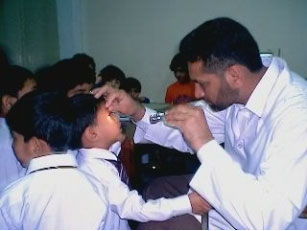
Screening of ear problems:
- with special attention to discharge, ear
drums and difficulty in hearing.
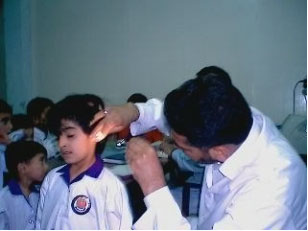
Screening of malnourished
children:
- with special attention to growth retardation,
chronic diarrhoea, repeated chest infections,
anaemia and rickets.
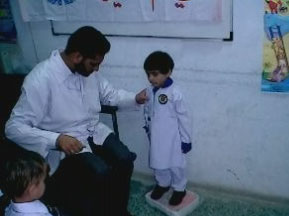
Health workers are questioning
the girls about their various problems
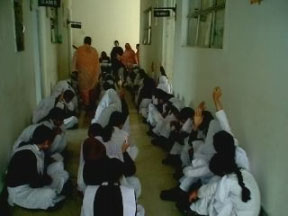
Mrs. Rahila Manzoor is
training teachers of blind school on how
to make sanitary pads and about personal
hygiene. These teachers in turn train the
blind girls in this knowledge and skills.
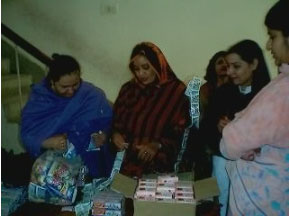
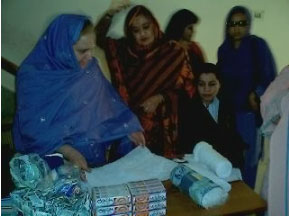
|